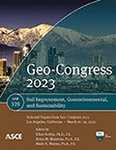The Effect of Level of Cementation and Geometry on Stability of Cemented Coastal Bluffs and Slopes
Publication: Geo-Congress 2023
ABSTRACT
Coastal bluff erosion and recession are among the common mechanisms altering the geomorphology of the coastline in California. The accelerated erosion rate increasingly threatens the stability of structures located on these bluffs. Previous researchers have investigated the effect of material properties and strength on the generation of the shear plane and failure modes of coastal bluffs and cliffs. Monitoring the morphology of the moderately cemented coastal bluffs with time has indicated that a comparison of material strength with the expected in situ minor principal stress distribution can be used as a criterion to assess bluff stability. However, the effect of varying factors such as cementation levels and bluff geometry and dimensions on stress distribution patterns and material properties that determine bluff failure susceptibility requires further investigation. While bond breakage and disturbance during sampling and transportation undermine the quality of recovered soil samples, artificial cementation methods (e.g., Portland cement) may not properly replicate the natural formation processes. Instead, microbially induced carbonate precipitation (MICP) is a ground improvement method that simulates the cementation processes that occur in natural geological settings. This method harnesses the activities of bacteria to generate cementitious precipitation among soil particles. The formation of the cementing agent improves the mechanical properties of the soil. In the past two decades, extensive studies have been devoted to understanding the cementation formation mechanism and the improvement of mechanical properties that can be used as a proxy for natural cemented soil for stability analysis. In the study presented herein, a series of FEM models were developed in SIGMA/W software. The effect of the different cementation levels and variation of bluff geometry on minor principal stress distribution was investigated. Results of the study demonstrated that although the cementation level of the materials determines the failure mode, the stress distribution mainly depends on the bluff geometry. The obtained results offer further insights into the failure mechanism of coastal bluffs as well as MICP-treated slopes for future field implementation of this soil improvement method.
Get full access to this article
View all available purchase options and get full access to this chapter.
REFERENCES
Bird, E. (2016). Coastal cliffs: morphology and management. Springer.
Collins, B. D., and Sitar, N. (2008). “Processes of coastal bluff erosion in weakly lithified sands, Pacifica, California, USA.” Geomorphology, 97(3–4), 483–501.
Collins, B. D., and Sitar, N. (2009). “Geotechnical properties of cemented sands in steep slopes.” Journal of Geotechnical and Geoenvironmental Engineering, 135(10), 1359–1366.
Collins, B. D., and Sitar, N. (2011). “Stability of Steep Slopes in Cemented Sands.” 137(January), 43–51.
DeJong, J. T., Mortensen, B. M., Martinez, B. C., and Nelson, D. C. (2010). “Bio-mediated soil improvement.” Ecological Engineering, 36(2), 197–210.
Feng, K., and Montoya, B. M. (2016). “Influence of Confinement and Cementation Level on the Behavior of Microbial-Induced Calcite Precipitated Sands under Monotonic Drained Loading.” Journal of Geotechnical and Geoenvironmental Engineering, 142(1), 04015057.
Ghasemi, P., Liu, Q., and Montoya, B. M. (2022). “Compressibility Behavior of MICP-Treated Sand Treated under Unsaturated Conditions.” Geo-Congress 2022, 309–317.
Ghasemi, P., and Montoya, B. M. (2022). “Field implementation of microbially induced calcium carbonate precipitation for surface erosion reduction of a coastal plain sandy slope.” Journal of Geotechnical and Geoenvironmental Engineering.
Gomez, M. G., Anderson, C. M., Graddy, C. M. R., DeJong, J. T., Nelson, D. C., and Ginn, T. R. (2017). “Large-Scale Comparison of Bioaugmentation and Biostimulation Approaches for Biocementation of Sands.” Journal of Geotechnical and Geoenvironmental Engineering, 143(5), 04016124.
Gomez, M. G., Martinez, B. C., DeJong, J. T., Hunt, C. E., DeVlaming, L. A., Major, D. W., and Dworatzek, S. M. (2015). “Field-scale bio-cementation tests to improve sands.” Proceedings of the Institution of Civil Engineers - Ground Improvement, 168(3), 206–216.
Griggs, G. B., and Patsch, K. B. (2004). “California’s coastal cliffs and bluffs.”, 53–64.
Hampton, M. A., and Griggs, G. B. (2004). “Formation, Evolution, and Stability of Coastal Cliffs – Status and Trends.”, (March), 129.
Montoya, B. M., and DeJong, J. T. (2015). “Stress-Strain Behavior of Sands Cemented by Microbially Induced Calcite Precipitation.” Journal of Geotechnical and Geoenvironmental Engineering, 141(16), 04015019.
Montoya, B. M., Evans, T. M., Wengrove, M. E., Bond, H., Ghasemi, P., Yazdani, E., Dadashiserej, A., and Liu, Q. (2021). “Resisting dune erosion with bio-cementation.” Proceedings of the 10th International Conference on Scour and Erosion (ICSE-10), M. Rice, J., Liu, X., McIlroy, M., Sasanakul, I., and Xiao, ed., Arlington, Virginia, USA, 11.
Nafisi, A., Mocelin, D., Montoya, B. M., and Underwood, S. (2019). “Tensile strength of sands treated with microbially induced carbonate precipitation.” Canadian Geotechnical Journal, 57(10), 1611–1616.
Nafisi, A., Montoya, B. M., and Evans, T. M. (2020). “Shear Strength Envelopes of Biocemented Sands with Varying Particle Size and Cementation Level.” Journal of Geotechnical and Geoenvironmental Engineering, 146(3), 04020002.
Terzis, D., Laloui, L., Dornberger, S., and Harran, R. (2020). “Full-Scale Application of Slope Stabilization via Calcite Bio-Mineralization Followed by Long-Term GIS Surveillance.” Geo-Congress 2020: Biogeotechnics, 65–73.
The City of San Diego. (2004). Land Development Code Coastal Bluffs and Beaches Guidelines. San Diego, CA.
Zamani, A., Montoya, B. M., and Gabr, M. A. (2019). “Investigating challenges of in situ delivery of microbial- induced calcium carbonate precipitation (MICP) in fine-grain sands and silty sand.” 1900(August 2018), 1889–1900.
Information & Authors
Information
Published In
History
Published online: Mar 23, 2023
Authors
Metrics & Citations
Metrics
Citations
Download citation
If you have the appropriate software installed, you can download article citation data to the citation manager of your choice. Simply select your manager software from the list below and click Download.
